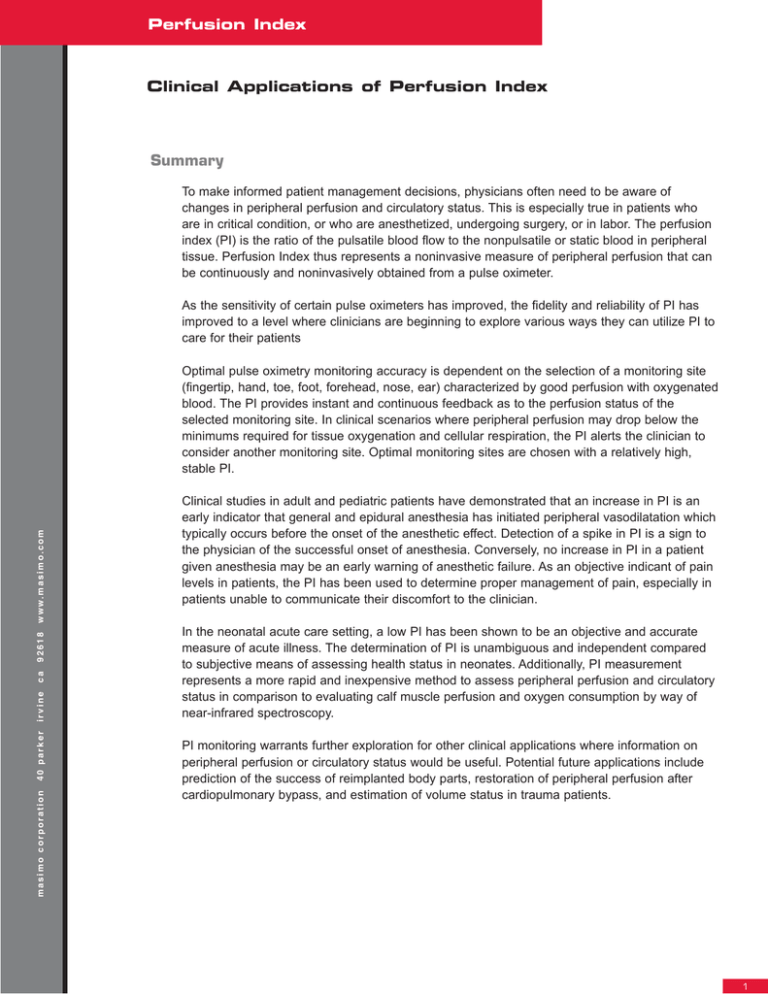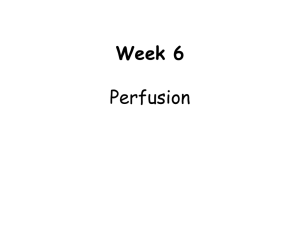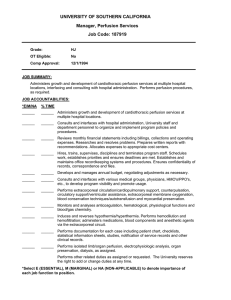Perfusion Index Summary Clinical Applications of
advertisement

Perfusion Index Clinical Applications of Perfusion Index Summary To make informed patient management decisions, physicians often need to be aware of changes in peripheral perfusion and circulatory status. This is especially true in patients who are in critical condition, or who are anesthetized, undergoing surgery, or in labor. The perfusion index (PI) is the ratio of the pulsatile blood flow to the nonpulsatile or static blood in peripheral tissue. Perfusion Index thus represents a noninvasive measure of peripheral perfusion that can be continuously and noninvasively obtained from a pulse oximeter. As the sensitivity of certain pulse oximeters has improved, the fidelity and reliability of PI has improved to a level where clinicians are beginning to explore various ways they can utilize PI to care for their patients masimo corporation 40 parker irvine ca 92618 w w w. m a s i m o . c o m Optimal pulse oximetry monitoring accuracy is dependent on the selection of a monitoring site (fingertip, hand, toe, foot, forehead, nose, ear) characterized by good perfusion with oxygenated blood. The PI provides instant and continuous feedback as to the perfusion status of the selected monitoring site. In clinical scenarios where peripheral perfusion may drop below the minimums required for tissue oxygenation and cellular respiration, the PI alerts the clinician to consider another monitoring site. Optimal monitoring sites are chosen with a relatively high, stable PI. Clinical studies in adult and pediatric patients have demonstrated that an increase in PI is an early indicator that general and epidural anesthesia has initiated peripheral vasodilatation which typically occurs before the onset of the anesthetic effect. Detection of a spike in PI is a sign to the physician of the successful onset of anesthesia. Conversely, no increase in PI in a patient given anesthesia may be an early warning of anesthetic failure. As an objective indicant of pain levels in patients, the PI has been used to determine proper management of pain, especially in patients unable to communicate their discomfort to the clinician. In the neonatal acute care setting, a low PI has been shown to be an objective and accurate measure of acute illness. The determination of PI is unambiguous and independent compared to subjective means of assessing health status in neonates. Additionally, PI measurement represents a more rapid and inexpensive method to assess peripheral perfusion and circulatory status in comparison to evaluating calf muscle perfusion and oxygen consumption by way of near-infrared spectroscopy. PI monitoring warrants further exploration for other clinical applications where information on peripheral perfusion or circulatory status would be useful. Potential future applications include prediction of the success of reimplanted body parts, restoration of peripheral perfusion after cardiopulmonary bypass, and estimation of volume status in trauma patients. 1 Perfusion Index Clinical Interpretation of the Perfusion Index Perfusion index is an assessment of the pulsatile strength at a specific monitoring site (eg. the hand, finger or foot), and as such PI is an indirect and noninvasive measure of peripheral perfusion. It is calculated by means of pulse oximetry by expressing the pulsatile signal (during arterial inflow) as a percentage of the nonpulsatile signal, both of which are derived from the amount of infrared (940 nm) light absorbed.1 The PI value is relative to a particular monitoring site, (eg. the fingertip or toe), of each patient as physiological conditions vary between monitoring sites and individual patients. Masimo SET pulse oximetry yields continual and simultaneous absolute values and trends with associated alarms for PI, arterial oxygen saturation (SaO2), and pulse rate using validated signal extraction technology. Because SET technology has sensitivity ratings proven to be the industry standard, the PI parameter yields clinically useful information. Other indices of perfusion derived through infrared absorption data lack the sensitivity technology of SET, limiting the power of the index. Changes in PI can also occur as a result of local vasoconstriction (decrease in PI) or vasodilatation (increase in PI) in the skin at the monitoring site. These changes occur with changes in the volume of oxygenated bloodflow in the skin microvasculature.2 The measurement of PI is independent of other physiological variables such as heart rate variability, SaO2, oxygen consumption, or temperature. The interpretation of PI depends on the clinical context to which it is applied. The PI generally changes in proportion to peripheral perfusion. In certain instances, however, such as in a patient attached to a heart-lung machine, perfusion can be good but the pulsatile part of the signal is nearly zero because of the absence of a pulse. Even in such an instance, the monitoring of PI in conjunction with examining the photoplethysmogram (pleth) waveform, can give the clinician an indication of the accuracy of the saturation readings. . masimo corporation 40 parker irvine ca 92618 w w w. m a s i m o . c o m The ability to trend the PI is critical; only the trend reveals the often subtle changes in perfusion that are otherwise missed by static displays. These subtle changes captured by the trend provide immediate clinical feedback of the efficacy of anesthesia, analgesia, and/or therapeutic intervention. Integrating user-formatable alarms with PI provides clinicians with immediate feedback to increases or decreases of PI to gain optimal results in the clinical management of the patient. Choosing a Monitoring Site in Adults The PI is useful for quickly evaluating the appropriateness of a monitoring site for pulse oximetry. A site with a high pulse amplitude (high PI number) generally indicates an optimal monitoring site for other pulse oximetry and Pulse CO-Oximetry measures. The fingertip is the standard monitoring site for pulse oximetry. The hand or foot (sometimes toe) is often used in neonatal patients. Surgical patients, however, are subject to unpredictable changes in peripheral perfusion, particularly with a large degree of variability in body temperature. Such changes in peripheral perfusion may have variable effects at different sensor locations. It is useful, therefore, to have an alternative to the standard fingertip sensor site. whiitepaper Monitoring Perfusion Index in Anesthetized Patients Current Clinical Settings for Measurement Most anesthetics produce a vasodilatative of Perfusion Index effect by way of increasing the vasodilatation • Anesthetized Surgical Patients threshold and decreasing the vasoconstriction - General anesthesia threshold.3 Anesthesia can also cause temperature - Epidural anesthesia redistribution, which further effects peripheral - Local anesthesia perfusion. Perfusion index has been considered • Critical Care Units a useful tool for accurately monitoring changes in (neonatal, pediatric, adult) peripheral perfusion in real time caused by certain • Pain Management Centers anesthetics. Masimo SET pulse oximetry was used to monitor PI in a study of 7 patients undergoing major abdominal surgery.4 In this study, the PI showed a statistically significant correlation with end-expiratory sevoflurane (R=0.005, p<0.001). In contrast, the more conventional forearm-finger tip gradient did not correlate with either sevoflurane concentration (R = 0.05, p = 0.5) or PI (R = 0.22, p = 0.15). These results suggest the future value of considering perioperative changes in PI during surgical procedures to monitor temperature redistribution, vasodilatation, and the efficacy of anesthesia. Is the Anesthesia Working? One valuable consideration during surgery is whether the anesthetized patient demonstrates any signs of a response to painful stimuli. If the patient cannot effectively report pain, as may occur in the anesthetized state, it becomes a challenge for the attending physician to evaluate the effectiveness of the anesthesia being used. A study sought to explore the effect of pain stimuli in healthy subjects anesthetized with sevoflurane by monitoring PI with Masimo SET pulse oximetry and heart rate as objective outcome measures.5 While anesthesia produces a vasodilatative effect, pain is known to induce vasoconstriction, and it was unknown whether a painful stimulus would still maintain vasoconstriction under the vasodilated condition in normothermic, anesthetized subjects. In this study, an electrical current was applied to the anterior thigh as the noxious stimulus. This painful stimulus produced a significant increase in heart rate from 62.5 ± 9.5 to 80.38 ± 13.18 bpm (p = 0.005). Before stimulus, the average PI was 11.07 ± 1.19 and after the electric stimulus there was a significant decline in the PI to 5.42 ± 2.39 (p<0.001). There was a correlation between endtidal sevoflurane concentration and perfusion index and the decline of the PI during painful stimulus. These findings support the hypothesis that the PI provides an indicator of painful stimulus that is independent of anesthesia concentration, and as such may be of clinical value in the assessment of pain in the anesthetized state. 3 Perfusion Index Is Epidural Block Working in Laboring Women? The Masimo® SET Radical pulse oximeter was used to monitor PI via the toe on 16 female patients in labor.6 These patients received epidural anesthesia via a catheter (1.5% lidiocaine plus 1:200,000 epinephrine inserted at either L2-3 or L3-4 followed by 0.25% bupivicaine) after baseline measurements of PI, blood pressure, and heart rate. A significant increase in PI was observed within 5 minutes (p<0.0001, 5 min. vs. baseline, paired t-test) followed by further increase at 20 minutes (p<0.0001, 20 vs. 5 min.). A steady increase in PI over time (trend) is an indicator of successful epidural placement, whereas a flat PI profile is a warning of a failed epidural in the obstetric patient. The authors concluded that an increased PI is an early indicator of the pharmacologic effect of anesthesia, often occurring before the onset of the anesthetic effect, providing the physician an early indicator of successful anesthetic administration. Epidural block is used routinely in children undergoing surgery, but it can be difficult to noninvasively evaluate the effect of the epidural in the presence of a general anesthesia.7 In a prospective study, 40 pediatric patients undergoing inguinal hernia repair received one shot lumbar epidural block (epidural space L2/3). These patients were monitored for PI (Masimo SET Radical pulse oximeter) in all 4 limbs. PI values in both lower limbs were significantly and statistically elevated from the pre-anesthesia baseline, and as compared with the upper limbs (lower PI compared to baseline) after 5 minutes [p<0.05; Figure 1]. In instances of failed epidural block (evidenced by elevated heart and respiratory rates and movement after incision) PI values remained low [Figure 1]. The authors concluded: “The pulse oximeter PI reflects the peripheral perfusion changed by epidural block. PI value can be used as a prediction for the effect of epidural block,” they continued. “As we use pulse oximeter routinely in every patient during operation, PI value is useful, objective, and non-invasive method to evaluate the effect of epidural block in pediatric patients.” masimo corporation 40 parker irvine ca 92618 w w w. m a s i m o . c o m Is Epidural Block Working in Children Undergoing Surgery? Figure 1. Elevation in the perfusion index in lower limbs after successful epidural block in pediatric patients undergoing hernia repair surgery.7 whitepaper PI as an Objective Predictor of Illness Severity in Newborns Under stress-free conditions, newborn skin perfusion is high by comparison with oxygen demand.8 In critical care patients, however, peripheral perfusion is related to the redistribution of cardiac output and oxygen supply to critical organs, ie. brain, heart, and adrenal glands. Peripheral perfusion is consequently affected. A prospective study was carried out in 101 neonates to evaluate the relationship between illness severity and PI.9 Perfusion Index, SpO2, and heart rate were monitored using the Masimo SET Radical pulse oximeter. A total of 43 neonates fit criteria for inclusion into the high severity group and 58 neonates met low severity group criteria (stratified based on SNAP II scores). The 2 groups were similar in terms of sex, gestational age, birth weight, body temperature, mean blood pressure, and use of peripheral vasoconstrictors and vasodilators. Significantly lower PI values (0.86±0.26 vs. 2.02±0.70, p<0.0001), SpO2 (93.3±5.4% vs. 95.1±3.9%, p<0.0001), and higher pulse rate (139±16 bpm vs. 133±17 bpm, p<0.0001) were found in the high severity group. The authors concluded a foot skin PI value of ≤1.24 is an unambiguous and accurate predictor of illness severity and is independent of subjective means of interpreting neonatal health status. These authors also demonstrated that when used in conjunction with oxygen saturation and pulse rate, a diminished PI becomes an important indicator of chorioamnionitis (HCA) in term newborns—a condition that is often subclinical and associated with neonatal morbidity and mortality. Relationship Between Perfusion Index and Calf Muscle Perfusion in Newborns In neonates, calf muscle perfusion and oxygen consumption are sometimes measured by near-infrared spectroscopy (NIRS) to provide information on circulatory failure of vital organs. Researchers proposed that PI and oxygenation assessment may provide a noninvasive means of providing indirect information on the circulatory failure of vital organs during circulatory shock. A study in 43 healthy neonates aged from 1 to 5 days aimed to compare foot PI to the 4 parameters measured by NIRS.10 In this study, the mean PI value was 1.26 ± 0.39 and correlated with calf muscle blood flow (p = 0.03) and not with oxygen consumption (VO2) or fractional oxygen extraction. The authors concluded that foot PI significantly correlated with calf blood flow, and that PI measurements are relatively easy and inexpensive, representing a simple bedside clinical tool for evaluating circulatory status in neonates that could become a standard for neonatal intensive care. Discussion and Conclusion The perfusion index is an indirect, noninvasive, and continuous measure of peripheral perfusion that provides useful information to the practicing physician in several clinical settings. Pulse oximetry provides a relatively simple means to continuously monitor PI in conjunction with other critical parameters, i.e., oxygen saturation and pulse rate. Furthermore, the PI provides a means of determining an appropriate monitoring site for pulse oximetry. Potential Future Applications for Monitoring Perfusion Index11 • Indication of circulatory function of reimplanted body parts such as fingers or hands • Restoration of peripheral perfusion after cardiopulmonary bypass • Estimation of volume status in trauma patients In the anesthesiology setting (surgical and obstetric), an increased PI is an indicator that a general or epidural anesthetic method is functioning in the adult or pediatric patient at the physiological level. An increased PI is an early indicator of the pharmacologic effect of the anesthesia, often occurring before the onset of the anesthetic effect providing the physician an early indicator of successful anesthetic administration. 5 Perfusion Index In the neonatal acute care setting, a low PI has been shown to be an objective indicator of severe illness. In conjunction with oxygen saturation and pulse rate, a diminished PI becomes an important indicator of a critical state of neonatal health. As such, the PI may be important to consider as a standardized, objective measure in addition to conventional subjective means of assessing the state of the neonate. PI determination has emerged as an important bedside diagnostic and monitoring tool with applications in multiple clinical settings. Advancements in signal processing and PI features have aided clinicians in further utilizing this valuable measurement. The ability to trend and set alarms for PI changes are now available in Masimo SET devices. Only the trend reveals the often subtle changes in perfusion that are otherwise missed by static displays. Integrating user formatable alarms with PI provide clinicians with immediate feedback to increases or decreases in PI. With further use and study, PI is likely to prove useful for evaluating patient outcomes and monitoring progress in other situations when peripheral perfusion and circulatory status should be evaluated. References 1. Goldman JM, Petterson MT, Kopotic RJ, Barker SJ. Masimo signal extraction pulse oximetry. J Clin Monit Comput. 2000;16:475-483. 2. Hales JR, Stephens FR, Fawcett AA, et al. Observations on a new non-invasive monitor of skin blood flow. Clin Exp Pharmacol Physiol. 1989;16:403-415. 4. Hager H, Reddy D, Kurz A. Perfusion index-a valuable tool to assess changes in peripheral perfusion caused by sevoflurane? Anesthesiology. 2003;99:A593. 5. Hagar H, Church S, Mandadi G, Pulley D, Kurz A. The perfusion index measured by a pulse oximeter indicates pain stimuli in anesthetized volunteers. Anesthesiology. 2004;101:A514. 6. Kakazu CZ, Chen BJ, Kwan WF. Masimo set technology using perfusion index is a sensitive indicator for epidural onset. Anesthesiology. 2005;103:A576. 7. Uemura A, Yagihara M, Miyabe M. Pulse oxymeter perfusion index as a predictor for the effect of pediatric epidural block. Anesthesiology. 2006;105:A1354. irvine 9. De Felice C, Latini G, Vacca P, Kopotic RJ. The pulse oximeter perfusion index as a predictor for high illness severity in neonates. Eur J Pediatr. 2002;161:561-562. 10. Zaramella P, Freato F, Quaresima V, et al. Foot pulse oximeter perfusion index correlates with calf muscle perfusion measured by near-infrared spectroscopy in healthy neonates. J Perinatol. 2005;25:417-422. 11. Barker SJ. Quoted by: Douglas E. Perfusion index used as a tool to confirm epidural placement. [Unpublished paper] 7341-3410D-0307 masimo corporation 8. Genzel-Boroviczeny O, Strotgen J, Harris AG, Messmer K, Christ F. Orthogonal polarization spectral imaging (OPS): a novel method to measure the microcirculation in term and preterm infants transcutaneously. Pediatr Res. 2002;51:386-391. 40 parker ca 92618 w w w. m a s i m o . c o m 3. Matsukawa T, Kurz A, Sessler DI, Bjorksten AR, Merrifield B, Cheng C. Propofol linearly reduces the vasoconstriction and shivering thresholds. Anesthesiology. 1995;82:1169-1180.



